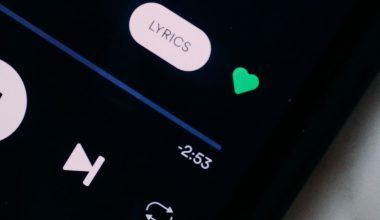Have you ever heard about AAC audio? It’s everywhere! From your favorite songs on Spotify to the videos you watch on YouTube, AAC is the magic behind the high-quality sound. The full form of AAC is Advanced Audio Coding, and it’s a way of compressing audio to make it sound amazing while keeping file sizes small.
Let’s explore what makes AAC so special, how it’s different from other formats, and why everyone loves it.
What is the Full Form of AAC?
AAC stands for Advanced Audio Coding. This format is designed to compress audio files without losing too much quality. It’s a “lossy” format, which means it removes some audio data, but don’t worry—it only removes parts your ears won’t notice! That’s why AAC is so good at balancing sound quality and file size.
For example:
- A song in AAC format can sound better than MP3 even though both have the same file size.
- AAC is also lightweight, which means it takes up less space on your phone or computer.
Why Was AAC Audio Invented?
Before AAC, the world had MP3, which was great for its time. But as technology improved, MP3 couldn’t keep up with the demand for better sound quality. People wanted:
- Smaller file sizes for their growing music libraries.
- Better sound quality for a richer listening experience.
In 1997, a group of tech giants like Dolby and Fraunhofer IIS created AAC to solve these problems. It became a better, more efficient version of MP3. Today, it’s the most popular audio format for music streaming, online videos, and even phone calls.
What Makes AAC Better Than MP3?
Many people still use MP3, but AAC is better in almost every way. Let’s compare:
| Feature | AAC Audio | MP3 Audio |
|---|---|---|
| Sound Quality | Clearer and richer | Good, but not as clear |
| File Size | Smaller for the same quality | Larger |
| Compatibility | Works on almost all devices | Works on most devices |
| Channels | Up to 48 (great for surround sound) | Limited to fewer channels |
Key Features of AAC Audio
Here are some amazing features that make AAC audio stand out:
- High-Quality Sound: AAC makes music and videos sound clearer and more vibrant, even at lower file sizes.
- Compact File Sizes: It saves storage space on your device without compromising on quality. You can store more songs in AAC than in other formats like MP3.
- Compatible Everywhere: AAC works seamlessly on most devices and platforms, including iPhones, Android phones, Windows PCs, and macOS.
- Supports Surround Sound: AAC can handle up to 48 audio channels, which makes it perfect for movies and games with surround sound effects.
How Does AAC Work?
AAC compresses audio files by removing unnecessary data, like sounds that are too high or low for human ears to hear. This is called “psychoacoustic modeling.” Don’t worry, though—it keeps the parts of the sound that matter the most.
Imagine squeezing a sponge filled with water. You remove the excess water but keep the sponge intact. That’s exactly how AAC keeps the “soul” of the sound while making the file smaller.
Where is AAC Used?
AAC is everywhere. Here’s how you might already be using it without even realizing:
- Music Streaming: Platforms like Spotify, Apple Music, and YouTube Music use AAC to deliver high-quality audio while saving data.
- Online Videos: YouTube videos use AAC for clear sound that syncs perfectly with the visuals.
- Mobile Devices: Most phones, including iPhones and Android devices, use AAC for ringtones, music, and video calls.
- Gaming: AAC powers immersive audio experiences in video games with its multi-channel support.
- Television and Movies: Platforms like Netflix and Hulu use AAC for their surround sound setups.
Benefits of AAC Audio for Listeners
- Crystal-Clear Sound: Enjoy every beat and instrument in your favorite songs.
- Saves Space: With smaller file sizes, you can store more music, podcasts, or audiobooks on your device.
- Perfect for Streaming: AAC uses less internet data while streaming high-quality audio.
- Global Compatibility: No matter what device you’re using, AAC works like a charm.
AAC Audio for Creators
If you’re a musician or content creator, AAC audio is your best friend. Here’s why:
- Efficient File Sharing: Smaller file sizes make it easier to share your music or videos online.
- Professional Sound Quality: AAC ensures your work sounds professional on all platforms.
- Wide Reach: AAC is accepted everywhere, from Spotify playlists to YouTube uploads.
AAC Audio vs Other Formats
| Format | Quality | File Size | Best Use Case |
|---|---|---|---|
| AAC | High | Small | Streaming and storing music |
| MP3 | Decent | Larger | Older devices |
| WAV | Excellent | Very Large | Professional recording |
| FLAC | Excellent (lossless) | Large | Audiophile-quality music |
Why AAC is Perfect for Today’s World
The digital world is all about speed, convenience, and quality. AAC fits perfectly because:
- Fast Streaming: It loads quickly, even on slower internet connections.
- Cross-Platform Support: It’s supported by almost every device and app.
- Saves Data: Ideal for people with limited internet or storage space.
Frequently Asked Questions About AAC Audio
1. What’s the full form of AAC audio?
AAC stands for Advanced Audio Coding.
2. Is AAC better than MP3?
Yes! AAC offers better sound quality and smaller file sizes compared to MP3.
3. Can I convert MP3 to AAC?
Yes, but the quality won’t improve because converting can’t add details that aren’t already there.
4. Is AAC audio lossless?
No, AAC is a “lossy” format, but it still provides excellent sound quality.
Fun Facts About AAC Audio
- Developed by Big Names: AAC was created by companies like Dolby and Apple.
- Used in Space: NASA uses AAC for audio communication in space missions.
- Preferred by Apple: All songs on iTunes and Apple Music are in AAC format.
Conclusion: Why Everyone Loves AAC
In simple words, AAC audio is a game-changer. It combines great sound quality, small file sizes, and wide compatibility. Whether you’re a casual listener, a movie buff, or a content creator, AAC makes life easier and your sound experience better.
So the next time you enjoy a crisp-sounding song or video, remember—you have AAC to thank for it!
Let’s Hear from You!
Do you use AAC audio? Have you noticed the difference in quality? Share your thoughts or questions in the comments below!
Related Articles:
For further reading, explore these related articles:
- The Ultimate Guide to Vocal Singing Your Journey to a Beautiful Voice
- The Wonderful World of Buskers and Street Performers: Stories, Struggles, and Success
For additional resources on music marketing and distribution, visit Deliver My Tune.





